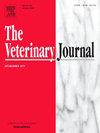Hip dysplasia induction: Establishment of a new surgical model in rabbits
IF 2.3
2区 农林科学
Q1 VETERINARY SCIENCES
引用次数: 0
Abstract
Hip dysplasia (HD) is an arthropathy with an incompletely understood pathophysiology. Existing induction HD models fall short of providing feasible data to test new therapeutic strategies. This study aimed to characterize and validate a new surgical model of HD in rabbits. Seventeen 6-week-old male New Zealand white rabbits were randomly assigned to 3 groups: GI (n = 3) – control group, with six normal hips (NH); GII (n = 7) – seven left instability surgery hips (ISH) and seven right surgery sham hips (SSH); GIII (n = 7) – seven left instability surgery hips, followed by hindlimb bandage immobilization for 3 days (ISHI) and seven right hips without surgery (HWS). The instability surgery was performed by sectioning the teres ligament and the sham by accessing the capsule without its section. After 14 weeks following the induction surgery, the rabbits underwent radiographic and computed tomographic studies and histopathological characterization of the hip joint based on the severity of cartilage structure and chondrocyte pathology. In the imaging assessment, the ISHI group was the only group presenting statistically significant differences in all four parameters, consistent with HD development (P < 0.05). In the histopathologic evaluation, the ISHI group showed a higher severity of cartilage damage and chondrocyte pathology with statistically significant differences when compared with the NH group (P < 0.05). As a result, the proposed rabbit model can be recommended for HD studies aiming to test therapeutic responses to osteoarthritis in vivo, representing a valuable tool in veterinary research fields.
求助全文
约1分钟内获得全文
求助全文
来源期刊

Veterinary journal
农林科学-兽医学
CiteScore
4.10
自引率
4.50%
发文量
79
审稿时长
40 days
期刊介绍:
The Veterinary Journal (established 1875) publishes worldwide contributions on all aspects of veterinary science and its related subjects. It provides regular book reviews and a short communications section. The journal regularly commissions topical reviews and commentaries on features of major importance. Research areas include infectious diseases, applied biochemistry, parasitology, endocrinology, microbiology, immunology, pathology, pharmacology, physiology, molecular biology, immunogenetics, surgery, ophthalmology, dermatology and oncology.
 求助内容:
求助内容: 应助结果提醒方式:
应助结果提醒方式:


